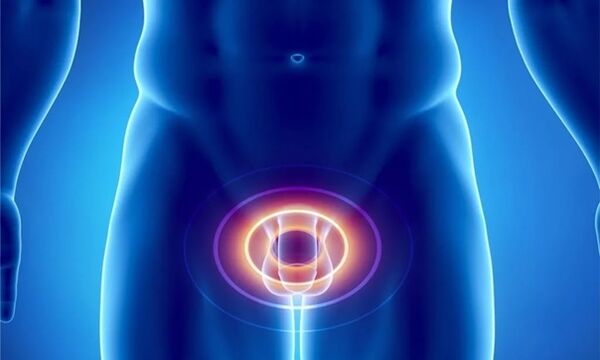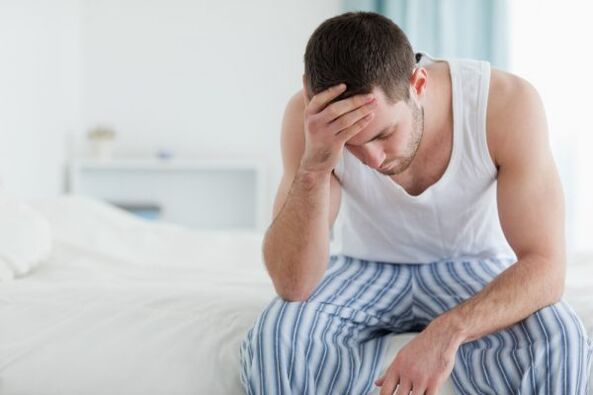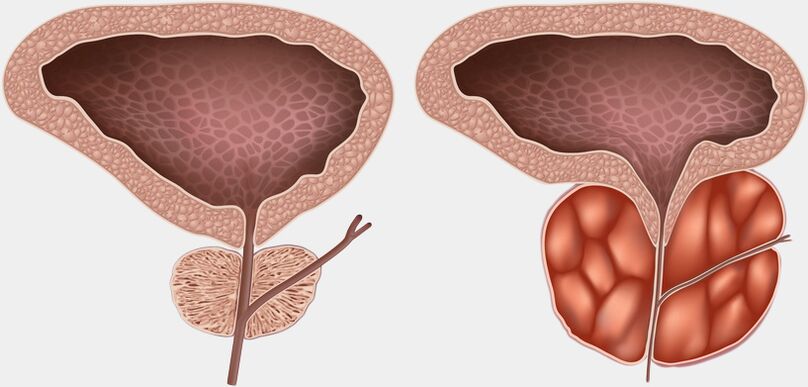
The prostate plays an important role in the functioning of the male body - it normalizes the existence of sperm, thins the sperm and participates in the regulation of hormonal levels.
Today, prostatitis in men is quite widespread, according to statistics - 30% of men 30-55 years old suffer from this pathology, which is an inflammatory phenomenon in the prostate gland.
Forms of prostatitis
Specialists distinguish several types of pathology:
- Chronic bacterial - a chronic type of pathology, provoked by a bacterial infection;
- Chronic abacterial - a chronic inflammatory process created by non-infectious causes;
- Acute form of pathology - chronic attacks of pain concentrated in the genital area;
- The asymptomatic form of the pathology is difficult to determine, usually only after regular preventive examinations.
Signs of developing prostatitis
How does prostatitis appear? Usually, doctors identify 6 signs that portray prostatitis. If a man noticed at least 2 signs from this list, then he should definitely consult a doctor:
- A poor urine flow with a short range;
- Difficulty urinating;
- Painful phenomena during urination;
- Duration of urination, urination, constant current;
- Partial emptying of the bladder;
- Frequent requests to urinate, especially at night.
The doctor will always be able to determine the first signs of prostatitis in men and treatment after diagnosis will be performed in a timely manner, with a positive result.
Causes of pathology
Experts talk about the following reasons for the formation of the disease:
- Weakening of immunity - protective barriers that prevent the occurrence of many viral infections are reduced;
- Infectious processes - viral elements, germs, bacteria through the blood or lymphatics enter the prostate. A sign of this phenomenon is that the temperature rises with prostatitis;
- A sedentary lifestyle - causes interruptions in blood supply, lack of oxygen;
- Interruptions in blood circulation due to stagnant moments in the genital area - occur due to debauched sex life, prolonged abstinence from sexual intercourse, irregular sexual intercourse.
Inflammation of the prostate can start due to the penetration of microbes, but for the development of infection, a pathogenic microflora is needed, which can be created as a result of the following factors - the presence of harmful addictions, constipation, hormonal disruptions, trauma, hypothermia, etc.
Symptoms of pathology
How does prostatitis appear? Important symptoms that indicate the onset of prostatitis are a difficult urination process, painful sensations at the moment. Frequent request to empty the bladder into small pieces indicates the development of pathology. Therefore, you should definitely consult a doctor in this situation, otherwise the inflammation will change into a chronic structure.
The initial stages of the pathology may be asymptomatic. Acute forms of the disease are much easier to determine - the manifestation of pathology is always sudden, sharp. It should be borne in mind that the course of the disease is due to the individual characteristics of the organism of each person.
The following symptoms of prostate inflammation are distinguished:
- Painful sensations in the perineal region;
- Temperature rise;
- Intestinal movements are accompanied by painful attacks;
- Power disorders;
- Frequent urination
- Increased sweating;
- General illness;
- Feeling of fullness in the bladder;
- Nervousness, sudden mood swings;
- Excretory phenomena from the urethra during bowel movements.
Usually, only a few of the above points appear.
Rising temperature
The development of an acute form of pathology is characterized by intoxication of the body, a febrile condition, and the temperature with prostatitis can also reach 40 degrees. Manifested pathology syndromes - violations in the field of urination. The acute type of prostatitis requires timely treatment, otherwise it can lead to negative consequences, up to surgery.
An extended decision to undergo a medical examination can affect the modification of the pathology into a chronic form, with a long period of development, which requires large financial costs for its treatment.
Pain attacks with the development of pathology
The complex structure of the prostate is accompanied by painful symptoms. Pain in prostatitis in men is not characterized by a precise localization. In the absence of a treatment process, pain attacks increase, spreading to other genitals. In advanced situations, an acute stage of the disease, adenoma, develops.
It is known that prostate pain in men is short-term, long-term.
Regular painful attacks lead to an uncomfortable lifestyle, the development of neuroses in men and worsen the quality of life.
Usually painful sensations arise in the following moments:
- During urination;
- During an erection;
- During sexual intercourse;
- After the end of sexual intercourse;
- During bowel movements;
- Due to prolonged abstinence or, conversely, ugly sexual intercourse;
- After hypothermia;
- Due to severe physical stress.
The lower back begins to hurt when pathology develops outside the prostate gland. The pain attacks are either dull or sharp. Due to the neglect of the pathology, painful sensations can last for a long time. Therefore, it is so important to consult a urologist in a timely manner because inflammation can go to the kidneys.

Also, pathologies in the prostate area are characterized by sharp sharp or sharp attacks in the groin area, rarely in the legs.
Elimination of painful sensations is possible using the following methods:
- Prostate massage;
- Phytotherapeutic treatment;
- Hormonal methods of pathology treatment;
- A special diet to normalize a person's condition;
- Antibacterial ways to eliminate harmful elements;
- Use of adrenergic blockers to facilitate urination.
Prostate adenoma or prostatitis?
Prostate adenoma is a benign neoplasm in the area of the prostate gland, usually this pathology is observed in men after 45-50 years. Hormonal imbalance is known as an important cause of the formation of pathology - over the years, the level of male hormones changes, decreases. There are also risk factors that contribute to the occurrence of pathology - obesity, stress, arteriosclerosis, harmful addictions.
The manifestation of the pathology is pronounced, therefore, already in the early stages of its development, it is possible to accurately determine a diagnosis.
The course of prostate adenoma in men is characterized by forward movement, development, the tumor provokes new clinical moments.
The symptoms of prostate adenoma and prostatitis in representatives of the strong half of humanity are similar - frequent difficulty urinating, burning sensation in the prostate, pain.
The course of prostate adenoma disease in men depends on the stage of this pathology.
The consequences of prostate adenoma in men are serious - kidney failure, cystitis, urolithiasis.
Diagnostic measures
The doctor can identify the signs of prostatitis in men and its treatment will be prescribed in a timely manner. To diagnose prostatitis, it is necessary to consult a urologist who will perform an examination and prescribe other important diagnostic procedures:
- Medical examination to compile an overall clinical picture;
- Taking urine tests;
- SST detection tests;
- Determining the presence or absence of infections, a tampon is taken from the urethra;
- Spill analysis;
- Genital ultrasound;
- Urography;
- Biopsy - if cancer is suspected.
Using the results of the above processes, the doctor designs a treatment regimen for the disease in a given patient.
Methods for treating prostatitis
How to treat this pathology? After the diagnosis of the disease, the doctor determines the treatment regimen for the pathology, usually an integrated approach is used, consisting of the following points:
- Antibacterial therapeutic methods - a specialist prescribes a course of treatment, that is, antibiotics to eliminate harmful trace elements leading to prostatitis. They also lower the temperature;
- Physiological influences, for example, by means of a laser, ultrasonic waves, electromagnetic waves.
- Traditional methods of treatment are used - warm bath procedures with medicinal herbs;
- Massage is performed in the area of the prostate gland - frees the ducts from stagnation, increases blood supply to the genitals;
- Herbal medicine - the use of decoctions of useful medicinal herbs, dietary supplements help strengthen the immune system, fights infection;
- Psychotherapeutic methods - due to prostatitis, a man develops negative psychological problems, confidence disappears, fear appears during sexual intercourse;
- Surgical methods of treatment are used in the advanced and severe stages of pathology development, for example, prostate abscess;
- Immune system correction - the doctor may prescribe the intake of vitamins, minerals, trace elements to strengthen the patient's immunity;
- Balanced diet, suitable for prostatitis, refusal of alcoholic beverages, smoking, fatty foods, restriction of salt intake, as well as drinking the most common water - at least 2 liters per day.

Preventive measures
It is important to monitor your health. To prevent the development of prostatitis, it is necessary to avoid exposure to factors that may lead to its occurrence:
- Do not cool it too much;
- Eat a balanced and healthy diet;
- Do physical exercises, sports;
- Have sex with a regular partner, protect yourself from SST;
- Perform an annual examination by a urologist for timely diagnosis of the presence or absence of the disease.
























